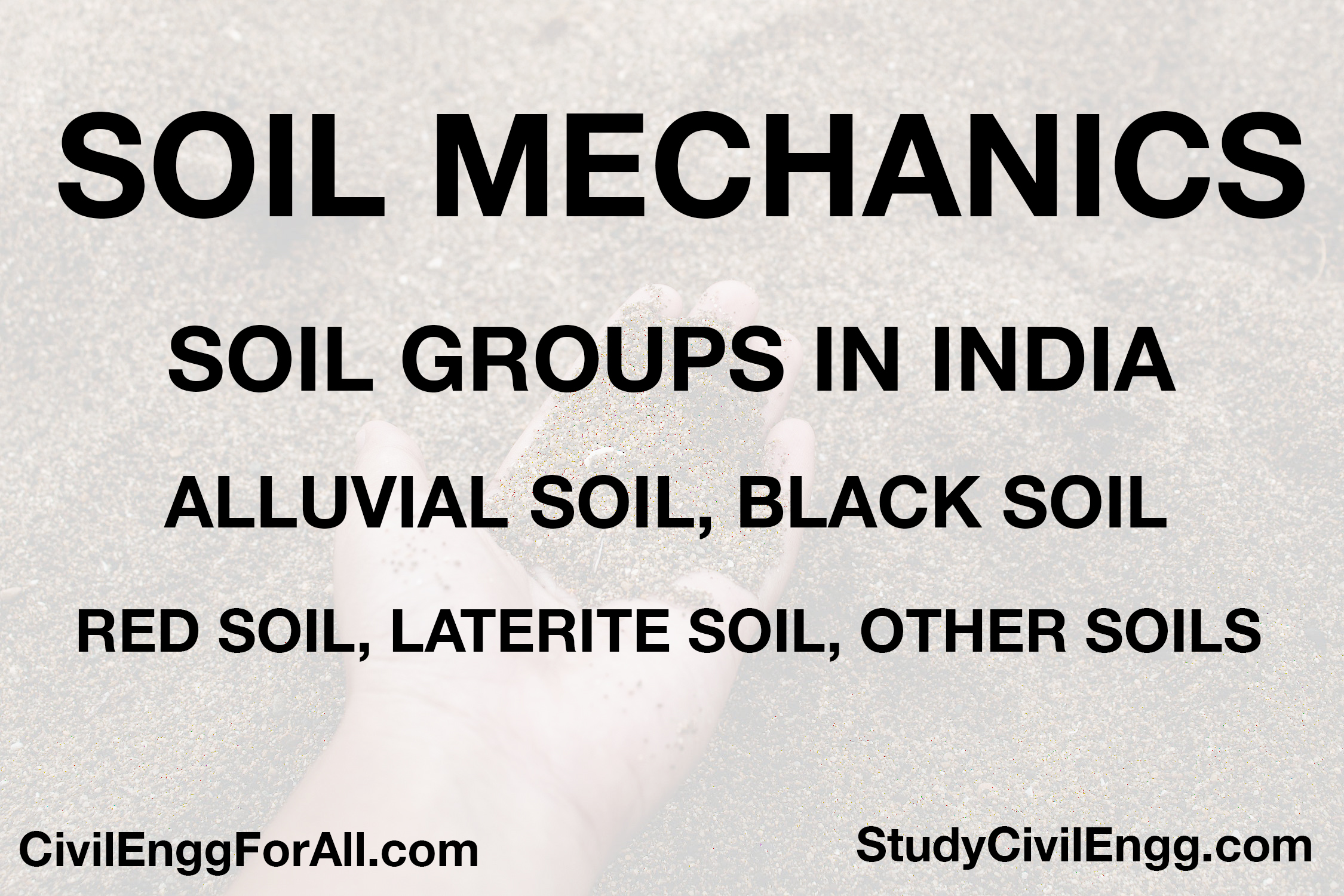SOIL GROUPS IN INDIA - SOIL MECHANICS (StudyCivilEngg.com)
SOIL GROUPS IN INDIA
SUBJECT : SOIL MECHANICS
The Indian soils may be divided into below four major group
- Alluvial soils
- Black soils
- Red soils
- Laterite soils
In addition to these four groups there exist another group of soils which includes desert soils, marine deposits and forest soils
Alluvial Soils
What are Alluvial Soils? Alluvial soils are formed by successive deposition of silt transported by rivers during floods, in the flood plains and along the coastal belts. The silt is formed from the weathering of the rocks by river water in the hilly terrain through which it flows. These soils form the largest and the most important group of soils in India. The alluvial soils occur in the Indo–Gangetic plains and Brahamaputra plains in north India, and also in the plains of various rivers in other parts of the country. These are in general deep soils, that is having more than 1 metre depth above a hard stratum, but the properties of these soils occurring in different parts of the country vary mainly because the parent material from which they have been derived are different. The soils vary from clayey loam to sandy loam.
Black Soils
What are Black Soils? Black soils have evolved from the weathering of rocks such as basalts, traps, granites and gneisses. These soils occur chiefly in the states of Andhra Pradesh, Gujarat, Madhya Pradesh, Tamil Nadu, Maharashtra and Karnataka. The colour of these soils range from dark brown to black. Further irrespective of the nature of the parent rock from which black soils have developed, they do not differ much in general physical and chemical properties. These soils are highly argillaceous and very fine grained. Thus these are heavy textured soils and their clay content varies from 40 to 60 per cent. They contain essentially the clay mineral montmorillonite. A special feature of the black soils is that they are plastic and sticky when wet and very hard when dry. These soils have high swelling and shrinkage characteristics. Their shearing strength is extremely low. They are highly compressible and have very low bearing capacity. It is extremely difficult to work with these soils. These soils possess a high water holding capacity but poor drainage. Black soils are subdivided as
- Shallow black soils which have a depth of 0.3 metre or less
- Medium black soils which are 0.3 metre to 1 metre in depth
- Deep black soils which are over 1metre in depth. Deep black soils are also referred to as black cotton soils since cotton is the most important crop grown in these soils.
Red Soils
What are Red Soils? Red soils are formed by the weathering of igneous and metamorphic rocks comprising gneisses and schists. These soils mostly occur in Tamil Nadu, Karnataka, Maharashtra, Andhra Pradesh, Madhya Pradesh and Orissa. They also occur in Bihar, West Bengal and some parts of Uttar Pradesh. These soils are in general loams, but the properties of these soils vary from place to place. The red soils have low water holding capacity and are well drained.
Laterite Soils
What are Laterite Soils? Laterite soils are formed by the weathering of laterite rocks. These soils occur mostly in Karnataka, Kerala, Madhya Pradesh, the Eastern Ghat region, Orissa, Maharastra, Malabar and in some parts of Assam. These soils are red or yellowish red in colour. These soils have low clay content and hence possess good drainage characteristics. The laterite soils are soft and can be cut with a chisel when wet. However, these harden with time. A hard crust of gravel size particles, known as laterite, exists near the ground surface. The plasticity of these soils decreases with depth as they approach the parent rock. These soils, especially those which contain iron oxide, have relatively high specific gravity.
Desert Soils
These soils are found in the arid areas in the north-western region in the states of Rajasthan, Haryana, and Punjab and are lying between the Indus river on the west and the ranges of Aravali Hills on the east. These soils are blown in from the coastal region and Indus valley, and are also derived from disintegration of rocks in the adjacent areas. These are light textured sandy soils, which are non-plastic and highly pervious.
Marine Deposits
Marine deposits are mainly confined to a narrow belt near the coast. In the south-west coast of India there are thick layers of sand above deep deposits of soft marine clays. The marine deposits have very low shearing strength and are highly compressible. They contain a large amount of organic matter. The marine clays are soft and highly plastic.
Forest Soils
Forest soils are formed by the deposition of organic matter derived from forest depth
FAQs COVERED IN THIS POST
What are different groups of Soils in India?
What is Alluvial Soil?
How is alluvial soil formed?
What is Black soil?
How is black soil formed?
What is Laterite soil?
In which areas of India can we see laterite soil in India?
How is Black soil classified?
In which areas of India can we find the Red soil?
In which areas of India can we find the Black soil?
Where in India can we find Alluvial soils usually?
What are desert soils?
What are Marine deposits?
What are forest soils?
Which is the most deepest soil in India?
Which of the Indian soils have the lowest clay content?
RELATED POST : INTRODUCTION & BASIC DEFINITIONS IN SOIL MECHANICS
ALSO READ
SURVEYING - STUDY ONLINE
BUILDING MATERIALS AND CONSTRUCTION - STUDY ONLINE
FLUID MECHANICS - STUDY ONLINE





Post a Comment